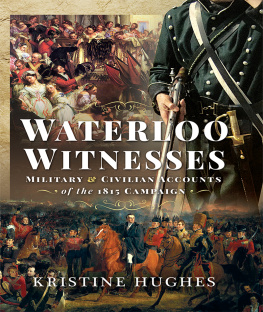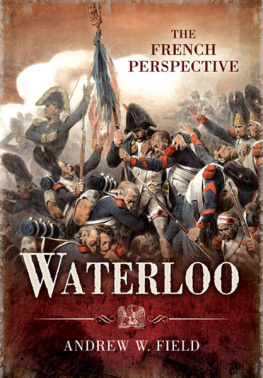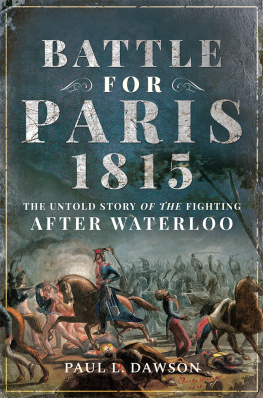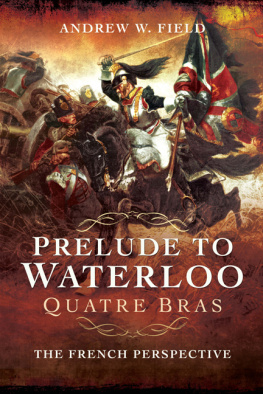Waterloo Witnesses
Waterloo Witnesses
Military and Civilian Accounts of the 1815 Campaign
Kristine Hughes
First published in Great Britain in 2021 by
PEN & SWORD MILITARY
An imprint of Pen & Sword Books Ltd
Yorkshire Philadelphia
Copyright Kristine Hughes, 2021
ISBN 978-1-39900-362-9
eISBN 978-1-39900-363-6
Mobi ISBN 978-1-39900-364-3
The right of Kristine Hughes to be identified as the author of this work has been asserted by her in accordance with the Copyright, Designs and Patents Act 1988.
A CIP catalogue record for this book is available from the British Library.
All rights reserved. No part of this book may be reproduced or transmitted in any form or by any means, electronic or mechanical including photocopying, recording or by any information storage and retrieval system, without permission from the Publisher in writing.
Pen & Sword Books Ltd incorporates the Imprints of Aviation, Atlas, Family History, Fiction, Maritime, Military, Discovery, Politics, History, Archaeology, Select, Wharncliffe Local History, Wharncliffe True Crime, Military Classics, Wharncliffe Transport, Leo Cooper, The Praetorian Press, Remember When, White Owl, Seaforth Publishing and Frontline Publishing.
For a complete list of Pen & Sword titles please contact
PEN & SWORD BOOKS LTD
47 Church Street, Barnsley, South Yorkshire, S70 2AS, England
E-mail:
Website: www.pen-and-sword.co.uk
or
PEN & SWORD BOOKS
1950 Lawrence Rd, Havertown, PA 19083, USA
E-mail:
Website: www.penandswordbooks.com
List of Plates
Arthur Wellesley, 1st Duke of Wellington by Sir Thomas Lawrence.
Grand Jubilee in Honour of Peace, Hyde Park, London 1814 , engraving
published by John Pitts.
Lieutenant John Fremantle.
Captain Lord Arthur Hill.
Congress of Vienna by Jean-Baptiste Isabey.
Lieutenant General Henry Paget.
Prussian Field Marshal Gebhardt von Blu cher by Sir Thomas Lawrence.
Miniature commissioned in Brussels by the Duke of Wellington from artist Simon-Jacques Rochard.
The Perilous Situation of Marshal Blu cher during the Battle of Ligny on 16 June 1815 after William Heath.
The Battle of Waterloo , engraving by H.R. Cook and John W. Cook after
Alexander Sauerweid.
The Duke of Wellington and the Most Distinguished Officers at the Battle of Waterloo , aquatint by Fry & Sutherland after Heath.
The Life Guards Charging the Imperial Guards at Waterloo by Franz Joseph Manskirsch.
Meeting of Wellington and Blucher at the close of the battle, by Thomas Jones Barker.
The Field of Waterloo, as it Appeared the Morning After the Memorable Battle by John Heaviside Clark.
Field of Waterloo: La Belle Alliance 1815 by military artist Denis Dighton.
The Village of Waterloo on 19 June 1815 by Sutherland after A.M.S., published 1816.
The Convalescent from Waterloo (1847) by William Mulready.
The Duke of Wellington on Copenhagen after Sir Thomas Lawrence.
Acknowledgements
Thanks are due to Victoria Hinshaw for accompanying me to various archives as I researched this book your assistance and decades-long friendship are much appreciated. As is the kindness of Beth Elliott, who facilitated portions of our research by providing lashings of roast beef and unflagging good humour.
Dr Jacqueline Reiter is to be applauded for her meticulous editorial skills and, along with Lynn Bryant, for sharing the funny side of history with me on a daily basis. A huge thank you goes out to Josh Provan, who was unstintingly generous with both his time and in-depth knowledge of the Napoleonic army. Many thanks are also due to Louisa Cornell for her constant belief in this book and in my ability to carry it off. Rory Muir has my gratitude for both his kindness and encouragement.
Finally, many thanks to my husband, Greg, for his patience and for having the good grace to share me with the Duke of Wellington from day one.
Preface
The history of a battle is not unlike the history of a ball. Some individuals may recollect all the little events of which the great result is the battle won or lost, but no individual can recollect the order in which, or the exact moment at which, they occurred, which makes all the difference as to their value or importance. [Wellington]
The events of Sunday, 18 June define the year 1815, if not an entire era. The Battle of Waterloo culminated in a defeat that some deemed impossible and a victory that would reshape governments and boundaries, make or break fortunes and touch thousands of lives in ways both large and small. It is, therefore, not surprising that a wealth of non-fiction accounts of the Battle of Waterloo should have been written, or that the battle plays a pivotal role in novels by William Makepeace Thackeray, Bernard Cornwell, Georgette Heyer and Victor Hugo, amongst others. The battle has been analysed, dissected and refought on paper a hundred times. Perhaps, though, the very best words ever written about that momentous day and that tumultuous time remain the first-person accounts recorded as events unfolded.
The Duke of Wellingtons oft-quoted words above, first written in a letter to John Wilson Croker shortly after the battle, illustrate his reluctance to sanction any retelling of the events of 18 June. Whilst Wellington maintained that his Dispatches should stand as the definitive, official account of the battle, there was little he could do to stop publishers from printing accounts of the battle (accurate or otherwise) or to prevent individuals from publishing their own contemporary letters or diary entries. Many of these personal accounts, whether published during their authors lifetimes or subsequently when found in family archives, have survived, including the Diary of Fanny Burney , the author otherwise known as Madame dArblay, who prefaced her account of the events surrounding the Battle of Waterloo with these words: I will write no account of these great events, which have been detailed so many hundred times, and so many hundred ways, as I have nothing new to offer upon them. I will simply write the narrative of my own history at that awful period.
The majority of the previous works on the Battle of Waterloo have either presented events from a strictly military or a thoroughly social point of view. By blending these accounts together, we gain a fuller picture of society as a whole during this period. Through their words, we come to know the people who took part in these events and who, thankfully, recorded their experiences, both in the run-up to the battle and during its aftermath. Their personal concerns seem more immediate and their eyewitness accounts are compelling. We meet legendary society beauties, military officers (dashing and otherwise), diplomats, adolescent girls, aristocrats and foot soldiers. Through these accounts we feel Madame dArblays anxiety as war becomes inevitable and she is separated from her husband. We chuckle at the long-suffering Spencer Madans descriptions of the Duchess of Richmonds caprices. Thomas Creeveys penchant for gossip lends insight into many of the personalities of the day, while the plight of Lady De Lancey brings home the heartbreak of death, both on and off the battlefield; and the accounts written by ordinary foot soldiers are by turns endearing, poignant and insightful.










